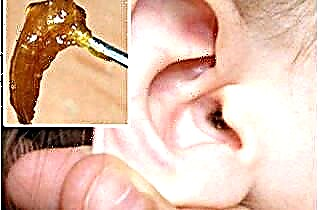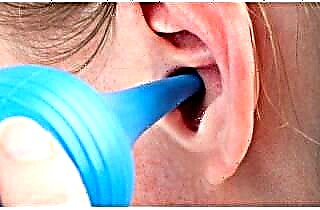In almost 90% of patients, otolaryngologists diagnose sulfur plugs in the ears. This is a problem that may not make itself felt for a very long time, but cause rather unpleasant complications, up to pressure sores of the auditory canal. To avoid this, you need to know how to flush your ears from the plugs. There are special preparations for this procedure and folk remedies. Any manipulations can be carried out only on the recommendation of the ENT after a thorough examination.
What are the types of traffic jams
The accumulation of sulfur in the ears occurs for many reasons, from the physiological structure of the ear canal to poor hygiene. Depending on the age of the plug and the living conditions of a person, formations can have the following consistency:
 Soft. Often these are recently accumulated corks, their color ranges from light yellow to dark brown. They are removed quite simply.
Soft. Often these are recently accumulated corks, their color ranges from light yellow to dark brown. They are removed quite simply.- Plasticine. The dense consistency and dark color of the cork may indicate not only the age of its appearance, but also that a person spends a lot of time in dry, dusty rooms.
- Stony. Such jams are most often formed as a result of working or living in conditions of high dustiness and insufficient humidity. They are the most difficult to remove, they consist of sulfur, sebum, dust, dead skin cells. They can be dark brown or even black.
Removal methods
The most common method to remedy this problem is to flush the earwax plugs. Ideally, it is carried out only in a polyclinic and exclusively by an otolaryngologist. However, patients do not always have the opportunity to visit a doctor several times a week, therefore there are also ways to wash at home.
The doctor decides how to rinse the ear from the sulfuric plug in the clinic. The choice of solutions and drugs is made only after a thorough examination of the patient. Some products are not suitable for removing congestion because they can damage the auditory nerve.
Most often, the difficulty of choice appears due to perforation of the tympanic membrane, recent otitis media and surgical interventions. If only plugs are found in the patient, and there are no concomitant diseases, then washing is done as follows:
 The doctor warms the cork softener (3% hydrogen peroxide, glycerin solution, etc.) to a temperature of 37 ⁰С. This is necessary in order not to injure the vestibular apparatus located in the ear.
The doctor warms the cork softener (3% hydrogen peroxide, glycerin solution, etc.) to a temperature of 37 ⁰С. This is necessary in order not to injure the vestibular apparatus located in the ear.- Before the introduction of the funds, the ear canal is leveled, for this the ear is pulled back and up.
- The softening drug is injected for 5-10 minutes, at which time it is advisable for the patient to lie on his side so that the sore ear is at the top.
- After that, the doctor uses a large syringe without Janet's needle, warm water is drawn into it. The patient sits down, fluid is injected into his ear canal under pressure, a special container is held under the ear, where it comes out together with the stopper.
- After 3-4 washes, an additional examination is carried out, if the washing of the ear from the plug was successful and there are no accumulations of sulfur, the auricle is dried with a sterile bandage, and the ear canal is closed with a cotton swab for 15-20 minutes.
Contraindications to home treatment
If you do not know how to rinse your ear from the plug yourself, be sure to go to the doctor, he will prescribe the best option for you to remove the wax yourself.
A preliminary consultation with an otolaryngologist is necessary for the following reasons:
 the doctor will be able to correctly determine the method and means for washing;
the doctor will be able to correctly determine the method and means for washing;- will confirm or deny the presence of traffic jams;
- find out if you have a perforation of the tympanic membrane - with it, the washing of the sulfur plug is not done;
- finds out if you have otitis media or other inflammatory diseases in which flushing is also prohibited;
- make sure that you do not have diabetes mellitus - this disease is also a contraindication for self-removal of plugs.
Home rinsing methods
In the absence of contraindications, the doctor will be able to tell you how to flush the sulfur plug yourself. He will recommend one of these options:
 Softening and removal. This is practically the same option as the one used in the clinic. Initially, you will drip 3% hydrogen peroxide or glycerin into your ear, you can also replace them with vegetable oil. It is necessary to ensure that the liquid is warm. After the cork has softened, you need to bend over the sink or bathtub so that the sore ear is at the bottom and send a stream of warm water into the ear canal. Instead of a shower, you can use a 300-500 ml syringe. After completing the procedure, the ear is gently wiped dry and closed with a cotton swab.
Softening and removal. This is practically the same option as the one used in the clinic. Initially, you will drip 3% hydrogen peroxide or glycerin into your ear, you can also replace them with vegetable oil. It is necessary to ensure that the liquid is warm. After the cork has softened, you need to bend over the sink or bathtub so that the sore ear is at the bottom and send a stream of warm water into the ear canal. Instead of a shower, you can use a 300-500 ml syringe. After completing the procedure, the ear is gently wiped dry and closed with a cotton swab.- Cerumenolytic drugs. This is the scientific name for drugs that are created specifically to remove sulfur plugs. Such funds are sold in pharmacies. They contain surface-active components, they penetrate directly into the cork, do not increase its size, unlike peroxide, and quickly soften. After the introduction of the agent into the ear canal, you need to lie down for a few minutes with the sore ear up, then roll over to the other side - the accumulation of sulfur will come out along with the remains of the cerumenolytic.
Important! Do not use products such as onion juice or garlic juice to remove plugs.... They can very quickly irritate the mucous membranes and skin and even cause burns!
Let's summarize
Before you rinse the sulfur plug yourself, you must definitely consult a doctor for advice. Only a specialist can rule out contraindications for home treatment and recommend suitable remedies for this. If the patient has the slightest irregularities, the procedure is performed only in the clinic.
Prevent traffic jams so that you never run into them, and you can maintain excellent health.

 Soft. Often these are recently accumulated corks, their color ranges from light yellow to dark brown. They are removed quite simply.
Soft. Often these are recently accumulated corks, their color ranges from light yellow to dark brown. They are removed quite simply. The doctor warms the cork softener (3% hydrogen peroxide, glycerin solution, etc.) to a temperature of 37 ⁰С. This is necessary in order not to injure the vestibular apparatus located in the ear.
The doctor warms the cork softener (3% hydrogen peroxide, glycerin solution, etc.) to a temperature of 37 ⁰С. This is necessary in order not to injure the vestibular apparatus located in the ear. the doctor will be able to correctly determine the method and means for washing;
the doctor will be able to correctly determine the method and means for washing; Softening and removal. This is practically the same option as the one used in the clinic. Initially, you will drip 3% hydrogen peroxide or glycerin into your ear, you can also replace them with vegetable oil. It is necessary to ensure that the liquid is warm. After the cork has softened, you need to bend over the sink or bathtub so that the sore ear is at the bottom and send a stream of warm water into the ear canal. Instead of a shower, you can use a 300-500 ml syringe. After completing the procedure, the ear is gently wiped dry and closed with a cotton swab.
Softening and removal. This is practically the same option as the one used in the clinic. Initially, you will drip 3% hydrogen peroxide or glycerin into your ear, you can also replace them with vegetable oil. It is necessary to ensure that the liquid is warm. After the cork has softened, you need to bend over the sink or bathtub so that the sore ear is at the bottom and send a stream of warm water into the ear canal. Instead of a shower, you can use a 300-500 ml syringe. After completing the procedure, the ear is gently wiped dry and closed with a cotton swab.

